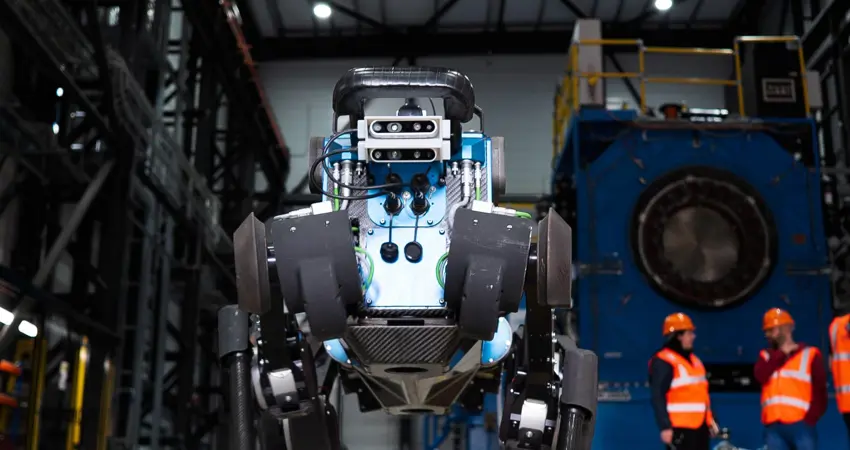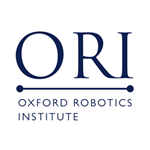14 Apr 2021
Dynamic Robot Systems Group at ICRA 2021 Conference

We are delighted to say that 10 papers from Dynamic Robot Systems Group will appear at the International Conference on Robotics and Automation (ICRA) this year (including several papers also appearing in the Robotics and Automation Letters journal). This body of work includes collaborations with ORI's Applied Artificial Intelligence Lab (Prof. Ingmar Posner), the Statistical Machine Learning and Motor Control Group (Prof. Sethu Vijayakumar, Edinburgh) and the Smart Robotics Group (Prof. Dr. Stefan Leutenegger, Imperial and TUM).
The paper preprints and videos are shown below.
![]() VIDEO "Learning Camera Performance Models for Active Multi-Camera Visual Teach and Repeat", Matias Mattamala, Milad Ramezani, Marco Camurri, Maurice Fallon, IEEE Intl. Conf. on Robotics and Automation (ICRA), 2021.
VIDEO "Learning Camera Performance Models for Active Multi-Camera Visual Teach and Repeat", Matias Mattamala, Milad Ramezani, Marco Camurri, Maurice Fallon, IEEE Intl. Conf. on Robotics and Automation (ICRA), 2021.
We present a Visual Teach & Repeat system using multiple non-synchronized cameras. It learns Camera Performance Models during the teach step, which are used during repeat to actively choose the most informative camera. We deployed it on an ANYmal quadruped and showed accurate path tracking in spite of occlusions and poor feature locations.
![]() VIDEO "Receding-Horizon Perceptive Trajectory Optimization for Dynamic Legged Locomotion with Learned Initialization", Oliwier Melon, Romeo Orsolino, David Surovik, Mathieu Geisert, Ioannis Havoutis, Maurice Fallon, IEEE Intl. Conf. on Robotics and Automation (ICRA), 2021.
VIDEO "Receding-Horizon Perceptive Trajectory Optimization for Dynamic Legged Locomotion with Learned Initialization", Oliwier Melon, Romeo Orsolino, David Surovik, Mathieu Geisert, Ioannis Havoutis, Maurice Fallon, IEEE Intl. Conf. on Robotics and Automation (ICRA), 2021.
We present a paradigm for advancing legged robot locomotion beyond short-horizon dynamic reactions, toward the type of intuitive and adaptive planning exhibited by animals and humans. Our approach allows ANYmal C quadruped to continually perceive and reason about upcoming terrain features, adjust the locations and timings of future footfalls and leverage momentum strategically to dynamically traverse challenging terrain.
![]() VIDEO "SKD: Keypoint Detection for Point Clouds using Saliency Estimation", Georgi Tinchev, Adrian Penate-Sanchez, Maurice Fallon, IEEE Robotics and Automation Letters, 2021.
VIDEO "SKD: Keypoint Detection for Point Clouds using Saliency Estimation", Georgi Tinchev, Adrian Penate-Sanchez, Maurice Fallon, IEEE Robotics and Automation Letters, 2021.
When localising a moving robot using (LIDAR) point clouds it is important that keypoints capture repeatability as well as matchability - the ability to be re identified at run time. This paper presents a novel detector which is trained on this joint skill and demonstrates a 50% improvement over and above just focusing on repeatability.
![]() VIDEO "Unified Multi-Modal Landmark Tracking for Tightly Coupled Lidar-Visual-Inertial Odometry", David Wisth, Marco Camurri, Sandipan Das, Maurice Fallon, IEEE Robotics and Automation Letters, 2021.
VIDEO "Unified Multi-Modal Landmark Tracking for Tightly Coupled Lidar-Visual-Inertial Odometry", David Wisth, Marco Camurri, Sandipan Das, Maurice Fallon, IEEE Robotics and Automation Letters, 2021.
It's challenging to jointly estimate LIDAR and visual odometry. A LIDAR sensor precisely measures ranges - but does so continuously. While a camera is almost instantaneous but struggles in the dark. How can you fuse both sensors (and inertial sensing) in a tight fusion? In this work we demonstrate such an approach which achieves the best of both worlds without needing handcrafted switches.
![]() VIDEO "Sparsity-Inducing Optimal Control via Differential Dynamic Programming", Traiko Dinev, Wolfgang Merkt, Vladimir Ivan, Ioannis Havoutis, Sethu Vijayakumar, IEEE Intl. Conf. on Robotics and Automation (ICRA), 2021.
VIDEO "Sparsity-Inducing Optimal Control via Differential Dynamic Programming", Traiko Dinev, Wolfgang Merkt, Vladimir Ivan, Ioannis Havoutis, Sethu Vijayakumar, IEEE Intl. Conf. on Robotics and Automation (ICRA), 2021.
This paper describes how to use sparse controls in dynamic motion planning for systems with actuation constraints such as in underwater or space applications. We also demonstrate its use for parsimonious controls on highly redundant systems e.g. on humanoids.
![]() VIDEO "A Passive Navigation Planning Algorithm for Collision-free Control of Mobile Robots", Carlo Tiseo, Vladimir Ivan, Wolfgang Merkt, Ioannis Havoutis, Michael Mistry, Sethu Vijayakumar, IEEE Intl. Conf. on Robotics and Automation (ICRA), 2021.
VIDEO "A Passive Navigation Planning Algorithm for Collision-free Control of Mobile Robots", Carlo Tiseo, Vladimir Ivan, Wolfgang Merkt, Ioannis Havoutis, Michael Mistry, Sethu Vijayakumar, IEEE Intl. Conf. on Robotics and Automation (ICRA), 2021.
We introduce a passive, optimisation-free planning algorithm for autonomous obstacle avoidance in 2D and 3D. Our experiments highlight its ability to generate smooth, stable trajectories in drones and wheeled robots and explore scalability to swarm applications.
![]() VIDEO "Inverse Dynamics vs. Forward Dynamics in Direct Transcription Formulations for Trajectory Optimization", Henrique Ferrolho, Vladimir Ivan, Wolfgang Merkt, Ioannis Havoutis, Sethu Vijayakumar, IEEE Intl. Conf. on Robotics and Automation (ICRA), 2021.
VIDEO "Inverse Dynamics vs. Forward Dynamics in Direct Transcription Formulations for Trajectory Optimization", Henrique Ferrolho, Vladimir Ivan, Wolfgang Merkt, Ioannis Havoutis, Sethu Vijayakumar, IEEE Intl. Conf. on Robotics and Automation (ICRA), 2021.
We evaluate two methods for enforcing dynamic constraints in direct transcription: forward dynamics and inverse dynamics. Our results show that using inverse dynamics is faster, requires fewer iterations, and is more robust to large timesteps.
![]() VIDEO "Real-Time Trajectory Adaptation for Quadrupedal Locomotion using Deep Reinforcement Learning", Siddhant Gangapurwala, Mathieu Geisert, Romeo Orsolino, Maurice Fallon, Ioannis Havoutis, IEEE Intl. Conf. on Robotics and Automation (ICRA), 2021.
VIDEO "Real-Time Trajectory Adaptation for Quadrupedal Locomotion using Deep Reinforcement Learning", Siddhant Gangapurwala, Mathieu Geisert, Romeo Orsolino, Maurice Fallon, Ioannis Havoutis, IEEE Intl. Conf. on Robotics and Automation (ICRA), 2021.
In this work we present a Reinforcement Learning based approach to perform closed loop tracking of dynamic long-horizon motion plans. This technique allows us to perform real-time trajectory adaptation to address inaccurate tracking which may have occurred due to external perturbations or sensing drifts.
![]() VIDEO"Introspective Visuomotor Control: Exploiting Uncertainty in Deep Visuomotor Control for Failure Recovery", Chia-Man Hung, Li Sun, Yizhe Wu, Ioannis Havoutis, Ingmar Posner, IEEE Intl. Conf. on Robotics and Automation (ICRA), 2021.
VIDEO"Introspective Visuomotor Control: Exploiting Uncertainty in Deep Visuomotor Control for Failure Recovery", Chia-Man Hung, Li Sun, Yizhe Wu, Ioannis Havoutis, Ingmar Posner, IEEE Intl. Conf. on Robotics and Automation (ICRA), 2021.
Imitation learning-based visuomotor control approaches usually lack the ability to recover from out-of-distribution states caused by compounding errors. We propose a novel uncertainty-based approach to detect and recover from failure cases, and demonstrate a significant improvement on common robot manipulation tasks: pushing, pick-and-place, and pick-and-reach.
![]() VIDEO"Elastic and Efficient LiDAR Reconstruction for Large-Scale Exploration Tasks", Yiduo Wang, Nils Funk, Milad Ramezani, Sotiris Papatheodorou, Marija Popovic, Marco Camurri, Stefan Leutenegger, Maurice Fallon, IEEE Intl. Conf. on Robotics and Automation (ICRA), 2021.
VIDEO"Elastic and Efficient LiDAR Reconstruction for Large-Scale Exploration Tasks", Yiduo Wang, Nils Funk, Milad Ramezani, Sotiris Papatheodorou, Marija Popovic, Marco Camurri, Stefan Leutenegger, Maurice Fallon, IEEE Intl. Conf. on Robotics and Automation (ICRA), 2021.
This paper presents an efficient, elastic 3D LiDAR reconstruction framework which can reconstruct using LiDAR with ranges of with high resolution (~5 cm) at multiple frames per second with only a CPU. Our system extends upon a RGB-D multi-resolution volumetric reconstruction technique to support LiDAR, and uses a submapping to dynamically correct the 3D map. We also introduce a novel submap clustering and fusion feature to improve the scalability of the proposed system.
Additional Recent Papers
In addition two further papers have been accepted to the Transactions on Robotics (TRO) and the International Conference on Automated Planning and Scheduling (ICAPS).
![]() VIDEO "Memory Clustering using Persistent Homology for Multimodality- and Discontinuity-Sensitive Learning of Optimal Control Warm-starts", Wolfgang Merkt, Vladimir Ivan, Traiko Dinev, Ioannis Havoutis, Sethu Vijayakumar, IEEE Transactions on Robotics (T-RO), 2021.
VIDEO "Memory Clustering using Persistent Homology for Multimodality- and Discontinuity-Sensitive Learning of Optimal Control Warm-starts", Wolfgang Merkt, Vladimir Ivan, Traiko Dinev, Ioannis Havoutis, Sethu Vijayakumar, IEEE Transactions on Robotics (T-RO), 2021.
We study the topology of datasets of trajectories to improve learning of discontinuity-aware warm-starts. Our clustering method based on homology enables identification of classes of trajectories and significantly improves warm-start success in complex environments.
![]() "Predicted Composite Signed-Distance Fields for Real-Time Motion Planning in Dynamic Environments", Mark Finean, Wolfgang Merkt, Ioannis Havoutis, International Conference on Automated Planning and Scheduling (ICAPS), 2021.
"Predicted Composite Signed-Distance Fields for Real-Time Motion Planning in Dynamic Environments", Mark Finean, Wolfgang Merkt, Ioannis Havoutis, International Conference on Automated Planning and Scheduling (ICAPS), 2021.




